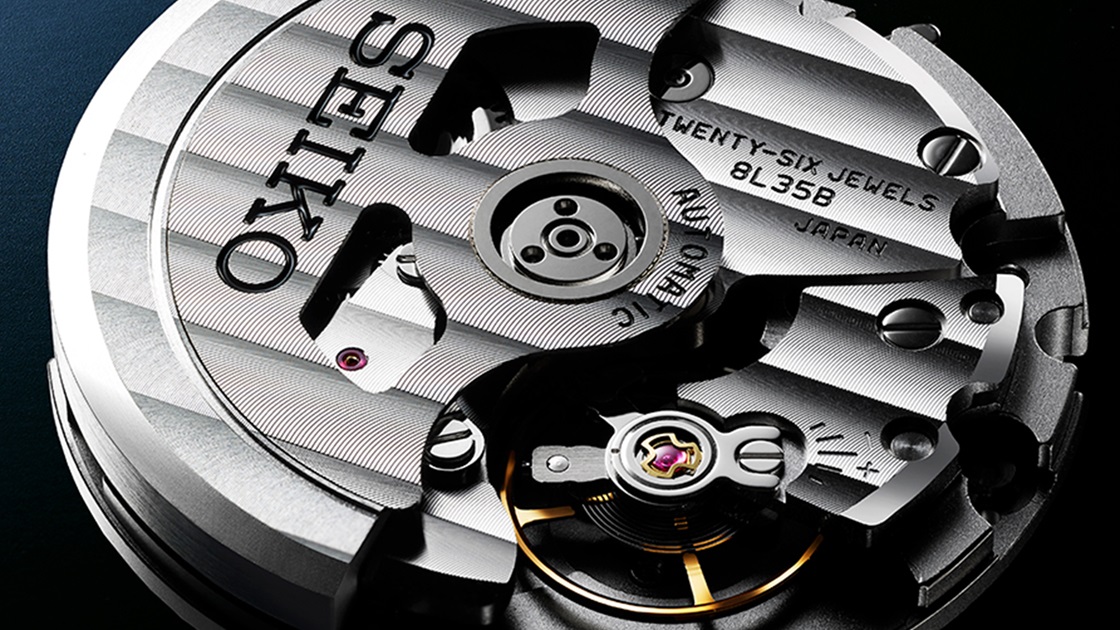Seiko, a Japanese company, has been a significant player in the watchmaking industry since the 19th century. Their innovations in watch movements have often set new standards for precision, durability, and accessibility. Seiko’s range of movements includes mechanical, quartz, and solar-powered variants, each with unique features tailored to a variety of users’ needs and preferences. These movements underpin the brand’s reputation for producing reliable and technologically advanced timepieces.

The mechanical movements from Seiko are especially revered among watch enthusiasts. The lineage of these movements can be traced back to the caliber 7S26, a workhorse that garnered praise for its balance between cost-efficiency and performance. Over time, Seiko has continued to refine its mechanical movements, providing wearers with the smooth sweep of the seconds hand, a characteristic often associated with high-quality mechanical watches.
Meanwhile, Seiko’s quartz movements boast remarkable accuracy and require minimal maintenance, making them a popular choice for everyday wear. The advancements in solar-powered watch movements further demonstrate Seiko’s commitment to innovation, offering users the convenience of a battery-free watch without compromising on functionality. These solar movements are not only environmentally friendly but also exemplify Seiko’s dedication to precision, as seen in calibers like the 5X53, which powers the Astron GPS Solar Dual-Time models and achieves an exceptional accuracy rate.
Seiko’s Heritage and Evolution

Seiko, a cornerstone of Japan’s watchmaking industry, was founded by Kintaro Hattori in 1881. Initially a jewelry shop in the Ginza area of Tokyo, it evolved into a company revered for its horological innovations. Seiko produced its first wristwatch, the Laurel, in 1913, signaling Japan’s entry into the wristwatch market.
Throughout its history, Seiko has been known for its commitment to precision and quality. In the 1960s, they introduced their Grand Seiko line, a testament to their craftsmanship, aiming to produce the best watches in the world. This line was home to noteworthy milestones, such as Seiko’s first manual-winding 36,000 vph (vibrations per hour) mechanical movement that was reintroduced 50 years later with the models like the Grand Seiko SLGW002.
The company has been a pioneer in various watchmaking technologies:
- 1969: Introduction of Seiko Astron, the world’s first quartz watch, which revolutionized the industry.
- 1988: Debut of Kinetic watches, that combined the self-energizing attributes of an automatic watch with quartz accuracy.
- 2005: Launch of Kinetic Perpetual, marrying the Kinetic auto-relay function with a perpetual calendar.
Seiko’s movements span from high-frequency mechanical calibers to cutting-edge quartz and Kinetic movements, embodying the brand’s spirit to innovate and refine watchmaking. They embrace both the nostalgia of manually winding a timepiece and the convenience and accuracy of modern technology, thus appealing to a diverse range of watch enthusiasts around the globe.
Understanding Watch Movements

The heart of any watch lies in its movement, also known as the caliber, which is responsible for timekeeping. There are four main types of watch movements: automatic, quartz, kinetic, and spring drive.
- Quartz Movements use a battery to send electricity through a small quartz crystal, making the crystal vibrate. These vibrations keep time and drive the motor to move the watch hands with a distinctive “tick.”
- Mechanical Watches operate without a battery. They rely on a mainspring to store energy, which is slowly released through gears to power the watch. Mechanical movements are either hand-winding or automatic.
- Automatic movements, or self-winding watches, harness energy through the wearer’s natural wrist motions to wind the mainspring. The Seiko Magic Lever and Diashock shock system are noteworthy innovations in this area. Automatic movements can also be hand-windable.
- Kinetic Movements are a unique Seiko innovation that combines elements from both quartz and automatic mechanisms. They generate energy from the wearer’s movements to charge a battery.
- Spring Drive, another Seiko technology, merges the accuracy of quartz with the perpetual energy of mechanical movements through a tri-synchro regulator system to maintain precise time without a battery.
The caliber dictates the frequency, measured in beats per hour (bph), with typical movements oscillating at 21,600 to 28,800 bph, translating to the smooth sweeping seconds hand motion in high-quality mechanical watches. The power reserve indicates how long a watch will function without being wound or worn.
Features like the hacking function, which stops the seconds hand when setting the time for synchronization, the use of durable materials like Spron 510 for the mainspring, a vertical clutch, and a column wheel for chronograph functions, enhance the movement’s precision and reliability.
Seiko’s calibers often have a diameter of 27.4mm, suitable for various watch sizes, and innovations like their proprietary magic lever winding system increase the efficiency of the automatic winding process.
Seiko’s Diverse Movement Types

Seiko is renowned for its innovative approach to watchmaking, offering a variety of movement types that cater to different preferences and requirements. From mechanical to solar-powered, each movement type showcases Seiko’s dedication to precision and quality.
Automatic Movements
Seiko’s automatic watch movements are revered for their reliability and craftsmanship. Notable among them is the 4R36 movement, which is a self-winding mechanical caliber featuring manual winding capabilities. Also, the 6R64 is a more advanced automatic movement that includes a power reserve indicator. Other automatic calibers like the 7S36 and NH35 are widely used for their robustness and accuracy.
Quartz Movements
The company has made significant strides in quartz technology with the introduction of the 9F quartz movement, which is appreciated for its precision. The Seiko Quartz Astron, the world’s first quartz watch, is a testament to Seiko’s pioneering work in quartz timekeeping. Additional quartz calibers include 7C46, 7N43, 1E20, 1F20, 1N00, and 1N01, each designed for specific functionalities and watch types.
Kinetic Movements
Seiko Kinetic watches combine the best of quartz and automatic technologies. They generate electrical energy from the wearer’s wrist motion to power a quartz movement. Calibers like 5M54, 5M62, 5M63, 5M65, and 5M85 are part of this innovative line, offering various functions including power reserve indicators.
Spring Drive Movements
A unique blend of mechanical and electronic watchmaking, the Spring Drive mechanism, is powered by a mainspring but regulated by Seiko’s exclusive Tri-Synchro Regulator. This technology allows for unparalleled precision, as evidenced by calibers like the 5D44 and 5D88.
Specialized Calibers
Seiko also produces specialized movements for different needs. For example, the 7D48 movement is designed for Seiko’s Direct Drive Kinetic line, combining kinetic energy with direct charging capabilities. The NH34, specially crafted for GMT watches, provides an additional time zone display.
Advanced Features
Seiko’s commitment to innovation is embodied in advanced features such as GPS and solar-powered technologies. The GPS-enabled calibers allow for atomic-level accuracy by syncing with global satellite signals. Moreover, their solar-powered movements, which can be found in calibers such as V157 and V158, harness light to eliminate the need for battery changes, underscoring Seiko’s eco-conscious approach to watchmaking.
Iconic Seiko Watch Models

Seiko has crafted a variety of watch models that have become icons in the watch industry, each distinguished by unique movements and design philosophies. Their range includes the versatile Seiko 5 Series to the high-end Grand Seiko timepieces, offering precision and sophistication across different price points.
Seiko 5 Series
The Seiko 5 Series is renowned for its affordability and reliability, appealing to a broad audience. It’s powered by the 4R36 movement, which provides both day and date display—a staple for the daily wear watch. A key feature of the Seiko 5 is its automatic winding, an attribute that made it a favorite since its introduction.
Seiko Prospex Collection
Seiko’s Prospex Collection is synonymous with ruggedness and is designed for professional use. Within the Prospex line, the Marinemaster series stands out with exceptional water resistance and durable constructions. These watches cater to divers and adventurers, often featuring the robust 6R15 movements or similar calibers tailored to withstand demanding environments.
Seiko Presage Line
The Seiko Presage Line is a bridge between affordability and luxury, showcasing Japanese craftsmanship with a touch more elegance. This series is known for its 4R35 movement, providing a reliable timekeeping experience. The Presage models often boast a more classic aesthetic, with enamel and textured dials that appeal to watch enthusiasts.
Grand Seiko Timepieces
Grand Seiko represents the pinnacle of the brand’s craftsmanship, competing with other luxury watch brands. They feature exclusive movements like the Caliber 9F, one of the most accurate quartz movements in the world, and the Caliber 6R54, an automatic movement with a long power reserve. Grand Seiko timepieces are characterized by their attention to detail, superb finishing, and timeless design.
Functionality and Innovation

Seiko’s watch movements are renowned for their blend of innovative features and reliable functionality. These mechanisms offer users a diverse range of utilities, from power management to precision timekeeping, affirming Seiko’s revered standing in horological engineering.
Power Reserve and Indicators
Seiko movements often come equipped with a power reserve indicator, a feature that informs the wearer how much run time is left before the next wind is necessary. As an example, mechanical movements like the hand-windable calibers have power reserves, with some offering upwards of a 41-hour duration. This capability gives users a tangible measure of their watch’s remaining operational autonomy.
GMT and Dual-Time Watches
Seiko’s GMT models stand out for their dual-time functionality, which is particularly useful for travelers. The mechanical GMT watches allow for simultaneous tracking of two time zones. A prime example of this feature is seen in Seiko’s implementations where a secondary hour hand rotates once every 24 hours, indicating an alternate time zone on the bezel or chapter ring.
Chronograph Mechanisms
Seiko has considerably advanced the field of chronograph watchmaking. Their chronograph mechanisms offer sophisticated stopwatch functionality, vital for precise time measurement in various applications. For instance, Seiko’s innovative chronographs are capable of providing split-second timing, which is a testament to the brand’s commitment to accuracy and precision.
High-Accuracy Standards
The pursuit of high-accuracy timekeeping is a hallmark of Seiko’s philosophy. The quartz movements, such as the 9F series, set a standard for super precision, reflecting their meticulous approach to manufacturing. Seiko quartz movements are celebrated for their nearly unrivaled precision, with some achieving an accuracy of just a few seconds deviation per year.
Design and Aesthetics

Seiko’s watch movements are not merely functional components; they embody a fusion of precision engineering and distinctive design aesthetics. The company’s approach carefully balances traditional watchmaking with innovative techniques, resulting in a visual and tactile experience that resonates with its audience.
Case and Dial Design
Seiko’s case design adheres to a guiding philosophy known as the “Grammar of Design,” introduced in the 1960s. This philosophy emphasizes clean lines, crisp angles, and a level of finishing that is meticulously crafted. Each case is engineered to bring out the best in light and shadow, featuring mirror-like polishing and sharp ridges that are both visually striking and ergonomically pleasing.
The dial of a Seiko watch is an area where artistry and precision converge. Watches in the Seiko Alpinist line, for example, showcase a dial design that is both functional and aesthetically appealing. The Alpinist series is known for its clear, easy-to-read dials and distinctive hands that are designed to offer maximum visibility even in challenging environments. The dial colors are often inspired by nature, reflecting the Alpinist’s outdoor heritage.
-
Hands: The hands on Seiko watches are designed to ensure legibility while contributing to the overall aesthetic of the timepiece. In some models, the hands possess a unique shape or style that is closely associated with the collection they belong to.
-
Dial: Beyond functionality, the dial often features intricate patterns or textures that capture and reflect light, adding depth and allure. This attention to detail helps create a connection between the timepiece and its wearer, making every glance at a Seiko watch a pleasurable experience.
The harmonious blend of design elements across the case and dial areas exemplifies Seiko’s dedication to aesthetics that are deeply rooted in Japanese culture. By prioritizing both design and functionality, Seiko ensures that each movement not only keeps precise time but also delivers it through a beautiful, well-constructed watch.

